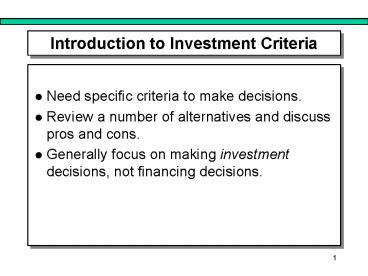Introduction to Investment Criteria PowerPoint PPT Presentation
1 / 23
Title: Introduction to Investment Criteria
1
Introduction to Investment Criteria
- Need specific criteria to make decisions.
- Review a number of alternatives and discuss pros
and cons. - Generally focus on making investment decisions,
not financing decisions.
1
2
Qualities of a Good Criteria
- Includes all relevant cash flows.
- Incorporates Time Value of Money.
- Accounts for risk of cash flows.
- Maximizes shareholder value.
2
3
Commonly Used Criteria
- Net Present Value (NPV)
- Internal Rate of Return (IRR)
- Profitability Index (PI)
- Payback Period
- Discounted Payback
- Accounting Returns
3
4
Core Example
- 1000 initial investment.
- 500 cash flow per year for 10 years.
- 5000 terminal expense in year 10.
- 12 discount rate.
4
5
Net Present Value
- Essentially same analysis as DCF.
- NPV PV(Cash Flows) - Initial Investment
- Discounting is done at a rate consistent with the
risk of the cash flows. - Decision Rule Accept if NPV gt 0
5
6
NPV Example
- To find the net present value, discount all
future cash flows and subtract the initial
investment. - Since NPV gt 0, you should accept this project.
6
7
Internal Rate of Return
- Similar to NPV, but solves for discount rate that
makes NPV zero. - Decision Rule Accept if IRR gt hurdle rate
- Good idea, but there are some limitations
- Multiple IRRs
- Ignores scale of project (mutually exclusive
projects)
7
8
IRR Example
- Since NPV gt 0 at 12, NPV 0 at gt 12.
- Using a financial calculator or trial-and-error,
NPV 0 at 42.3. - Verify this solution by pulgging it in the
formula.
8
9
IRR Flaw Multiple IRRs
- In this example, there is actually a second
discount rate, 7.4, that makes the NPV0.
9
10
IRR Flaw Mutually Exclusive Projects
- Consider two mutually exclusive projects
- A has a 2500 initial outlay and pays 500 per
year for 10 years. - B has a 200 initial outlay and pays 50 annually
for 10 years. - At a 12 discount rate, which one do you choose?
- IRRA 15 IRRB 21
- But NPVA 325 NPVB 83
10
11
Profitability Index
- Same idea as NPV, but an index instead of a
dollar amount. - PI PV(Cash Flows)/Initial Investment
- Decision Rule Accept if PI gt 1
- Problems
- Ignores scale of projects
- Harder to interpret than NPV
11
12
PI Example
- Returning to the core example
- Since PI gt 1, accept the project.
- Note that there are no units, it is an index.
12
13
PI Flaw Ignores Scale
- Recall the projects A and B.
- We saw that
- NPVA 325 NPVB 83
- IRRA 15 IRRB 21
- The PI for each project is
- PIA 1.13 PIB 1.41
- Like IRR, PI ignores the scale of the project.
13
14
Payback Period
- Idea Measure how long it takes to recover
investment, - Decision Rule Accept if Payback Period lt hurdle
period - Problems
- Completely ignores TVM
- Largely ignores risk of cash flows
- Completely ignores any CF after Payback Period
- Arbitrary hurdle period
- Biased towards short-term investments
14
15
Payback Period Example
- To recover the 1000 investment in the core
example, - Year 1 500
- Year 2 500
- It takes 2 years to recover the investment.
- You would accept the project based on this
criteria if the hurdle payback period is at least
2 years.
15
16
Payback Flaw Ignores TVM
- The present value of the first 2 payment is less
than 1000 because of TVM. - This rule would give the same decision if the
first two payments were - 0 in year 1, 1000 in year 2
- 500 in year 1, 500 in year 2
- 999 in year 1, 1 in year 2
16
17
Payback Flaw Ignores CF Risk
- This method also basically ignores the risk of
the cash flows since there is no way to formally
include it in the analysis. - By ignoring distant cash flows altogether, there
is some sense in which risk is considered.
17
18
Payback Flaw Ignores Distant CF
- What if the cutoff period is 5 years and cash
flows are 1000 initial investment, 0 for the
next 5 years and 1 million in year 6? - The payback method would reject this project
- The IRR is over 215.
- NPV would be large and positive at any reasonable
discount rate.
18
19
Payback Flaw Arbitrary Hurdle
- In the prior example, if the cutoff was 6 years
we would take the project. - There is really no good way to determine an
appropriate payback period hurdle.
19
20
Payback Flaw Short-term Bias
- The criteria is naturally biased against
long-term projects. - This is a serious problem that can lead to
under-investment and it does not maximize
shareholder value.
20
21
Discounted Payback
- Accounts for TVM and CF risk by discounting Cash
Flows - Still suffers from other weaknesses of Payback
Method
21
22
Discounted Payback Example
- Adding up the discounted cash flows, the initial
investment is recovered in the third year.
22
23
Accounting Returns
- Common measures are ROA and ROE
- Flaws
- Ignores TVM
- Ignores future performance
- Uses accounting figures, not cash flows
23

